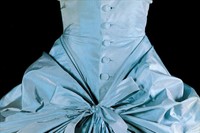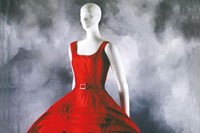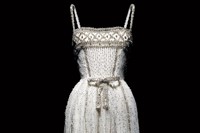From Poiret to Pucci, Doucet to Dior, Vionnet to Valentino, Valerie Steele, director and chief curator of the Museum at the Fashion Institute of Technology (MFIT), selects the one hundred most iconic dresses of the 20th century...
In the late 1920s, Coco Chanel designed what became a revolutionary collection of dresses. Unfussy and entirely black, they became ubiquitous in popular culture, spawned the term ‘little black dress’ and prompted Vogue to describe the chic creations as a “…uniform for all women of taste.” And yet throughout her career, Chanel attributed much of the success of her dresses to the women who wore them. “Look for the woman in the dress” the French designer once instructed. “If there is no woman, there is no dress.”
A new book, The Impossible Collection of Fashion, which focuses on the craftsmanship behind the designs seems to suggest otherwise. Written by Valerie Steele, director and chief curator at New York's Museum at the Fashion Institute of Technology, it features 100 of the most exquisite dresses the 20th century had to offer. It celebrates their beauty, but also examines how the dress, which was the default form of attire for women until the 60s, was subject to a series of radical alterations, which were sympathetic to the female form, and contributed to the liberation of women. To illustrate, Paul Poiret’s creations contributed to the demise of the corset, while Mariano Fortuny invented flowing, pleated gowns. Madeleine Vionnet introduced a bias cut and Chanel herself, according to Steele, was a "modernist" who encouraged fashion to be viewed as a “part of daily life".
The rich anthology also assesses the impact of designers whose names have slipped into obscurity, such as Jeanne Paquin and Charles Frederick Worth, who controlled the premier couture houses of the 20th century. The haute-couture designer Jacques Farth whose dresses were coveted by Ava Gardner, Rita Hayworth and Greta Garbo is another example of how a sublime talent – the house closed in 1957 – can easily be forgotten, despite, as Steele notes, being regarded as “the dauphin to Dior’s king.” Other high points come in the form of less conventional couture designers. As well as Issey Miyake and Yohji Yamamoto, the book celebrates the avant-garde contributions of Rei Kawakubo for Comme des Garçons by including the controversial 1997 nylon ‘Body Meets Dress-Dress Meets Body” dress. Featuring a back, which protruded outwards, many critics thought it worked against the female figure. But Kawakubo was always clear of her intentions. Her designs were only fit for a woman “not swayed by what her husband thinks.”
Intent on showing the clear evolution of fashion, Steele painstakingly sifted through Images of dresses in London, Paris, New York, Kyoto, Los Angeles, Sydney and elsewhere to compile the book. The foreword describes how she honed in on museums and private collections (such as those possessed by various design houses) in order to “reinforce the idea of a collection of fashion masterpieces,” she writes. Not to mention that, “many of the corresponding images would be unfamiliar to most viewers and, therefore, more interesting than the usual array of famous fashion photographs.”
As well as documenting the remarkable ability of couture to survive, The Impossible Collection of Fashion is a book that inspires, and demonstrates why the dress – despite no longer being compulsory wear for women - continues to be the cornerstone of every collection.
The Impossible Collection of Fashion by Valerie Steele is published by Assoline and available now.
Suggested Reading: Read more about Rita Hayworth in Vintage Style here.
Text by Fiona Cook



